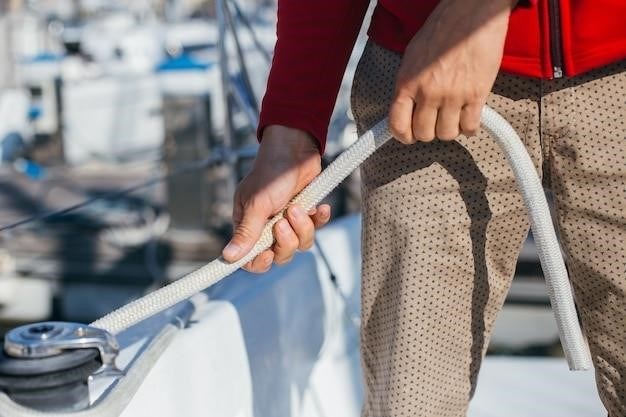
pontoon guide
Pontoon Boat Guide
This comprehensive guide delves into the world of pontoon boats‚ providing valuable information for both novice and experienced boaters. From understanding the different types and features to navigating safety protocols and maintenance tips‚ this guide equips you with the knowledge to make informed decisions and enjoy the pleasures of pontoon boating.
Introduction
Pontoon boats have become a staple on lakes and waterways worldwide‚ offering a unique blend of stability‚ spaciousness‚ and versatility. Their distinctive design‚ featuring a large‚ flat deck supported by buoyant pontoons‚ provides ample room for relaxation‚ entertainment‚ and various activities. Pontoon boats are renowned for their stability‚ making them ideal for families‚ groups of friends‚ and individuals seeking a comfortable and enjoyable boating experience. This guide will serve as your comprehensive resource for all things pontoon‚ exploring their diverse types‚ features‚ uses‚ safety considerations‚ and everything in between.
The origins of pontoon boats can be traced back to the early days of watercraft‚ with the term “pontoon” derived from the Latin word “pontone‚” meaning “flat-bottomed boat.” These early pontoon-like structures were often used for bridging rivers and waterways‚ showcasing the inherent stability and buoyancy of the design. Over time‚ pontoon boats evolved into recreational vessels‚ gaining popularity for their spacious decks and adaptable nature.
Today‚ pontoon boats offer an array of customization options‚ allowing owners to personalize their vessel to suit their individual needs and preferences. From basic models for fishing and cruising to luxurious versions featuring amenities like kitchens‚ bathrooms‚ and entertainment systems‚ pontoon boats cater to a wide spectrum of boating enthusiasts.
Types of Pontoon Boats
The world of pontoon boats offers a variety of configurations‚ catering to different preferences and boating styles. From the classic two-tube design to the more stable three-tube option‚ each type presents distinct advantages and characteristics. The choice between these variations depends on factors such as intended use‚ desired speed‚ and desired seating capacity.
The traditional two-tube pontoon boat is a popular choice for its simplicity and affordability. It typically features two large‚ buoyant pontoons that provide ample stability for leisurely cruising and fishing. Two-tube pontoons tend to ride a little smoother due to their ability to cut through the water rather than ride on top of it. However‚ they might not achieve the same top speeds as their three-tube counterparts.
Three-tube pontoon boats‚ often referred to as “tritoons‚” are known for their exceptional stability and enhanced performance. The addition of a third pontoon in the center provides a wider base and increased buoyancy‚ making them ideal for larger groups and those seeking a more stable ride‚ even in rough water conditions. The three-tube design allows the boat to plane more easily‚ resulting in faster speeds and improved handling.
Beyond the number of pontoons‚ pontoon boats can be further categorized by their intended use‚ such as fishing pontoons‚ party pontoons‚ and luxury pontoons. Fishing pontoons often feature specialized features like live wells‚ rod holders‚ and fish finders‚ while party pontoons prioritize spacious seating areas‚ entertainment systems‚ and amenities for socializing. Luxury pontoons take comfort and opulence to a new level‚ incorporating features like kitchens‚ bathrooms‚ and premium upholstery.
Pontoon Boat Features
Pontoon boats are renowned for their versatility and adaptability‚ allowing for a wide range of customization to suit individual needs and preferences. From spacious decks and comfortable seating to innovative features and advanced amenities‚ pontoon boats offer a unique blend of functionality and luxury. These features enhance the overall boating experience‚ making them suitable for various activities‚ from leisurely cruising and entertaining guests to fishing and watersports.
One of the defining characteristics of pontoon boats is their expansive deck space. This generous area provides ample room for seating‚ dining‚ and lounging‚ creating a comfortable and inviting environment for passengers. The flat deck design also facilitates easy movement and access‚ making it convenient for activities like fishing‚ waterskiing‚ or simply enjoying the view. Pontoon boats often feature modular seating arrangements‚ allowing owners to personalize the layout to accommodate different group sizes and preferences.
Beyond the basic deck layout‚ pontoon boats are equipped with a variety of features that enhance both functionality and comfort. Some common features include⁚
- Canopies and Biminis⁚ These provide shade from the sun and protection from the elements‚ creating a more enjoyable experience‚ especially during hot summer days.
- Sound Systems⁚ Integrated sound systems allow for music playback‚ enhancing the ambiance and entertainment factor on board.
- Kitchens and Galley Areas⁚ Some pontoon boats feature built-in kitchens with appliances like grills‚ refrigerators‚ and sinks‚ allowing for convenient food preparation and on-board dining.
- Bathrooms⁚ Larger pontoon boats may include private bathrooms‚ offering added convenience and privacy for longer trips.
- Storage⁚ Pontoon boats often have ample storage space for gear‚ supplies‚ and personal belongings‚ ensuring a clutter-free and organized environment.
Pontoon Boat Uses
Pontoon boats are incredibly versatile watercraft‚ suitable for a wide range of activities and enjoyed by individuals‚ families‚ and groups alike. Their stability‚ spaciousness‚ and adaptability make them ideal for everything from leisurely cruising and entertaining guests to fishing‚ watersports‚ and even overnight trips.
One of the most popular uses for pontoon boats is leisurely cruising. Their stable platform and comfortable seating make them perfect for enjoying scenic views‚ relaxing on the water‚ and simply soaking up the sunshine. Pontoon boats are often used for sightseeing tours‚ allowing passengers to admire the beauty of lakes‚ rivers‚ and coastal areas. Their open design also provides unobstructed views‚ enhancing the overall experience.
Pontoon boats are also excellent for entertaining guests. With their spacious decks and comfortable seating‚ they can easily accommodate large groups. They are often used for parties‚ family gatherings‚ and social events on the water. The open layout allows for easy movement and interaction‚ making them ideal for socializing and creating a fun atmosphere.
Fishing enthusiasts appreciate the stability and spaciousness of pontoon boats for fishing trips. The wide‚ flat deck provides ample room for casting lines‚ storing gear‚ and maneuvering around the boat; Many pontoon boats are equipped with fishing-specific features‚ such as rod holders‚ live wells‚ and fish finders‚ further enhancing their suitability for fishing.
Beyond cruising and fishing‚ pontoon boats are also well-suited for watersports. Their stability makes them ideal for towing water skiers‚ wakeboarders‚ and tubers. The spacious deck can also serve as a platform for swimming‚ diving‚ and other aquatic activities.
Pontoon Boat Safety
Pontoon boat safety is paramount‚ ensuring a fun and enjoyable experience for everyone on board. Understanding and adhering to safety measures is crucial to minimizing risks and preventing accidents on the water. The following safety tips can help you navigate the waters responsibly and enjoy a worry-free boating experience.
Before embarking on any pontoon boat journey‚ it’s essential to conduct a thorough pre-departure inspection. Check the engine‚ fuel levels‚ and battery‚ ensuring everything is in proper working order. Inspect the pontoons for any signs of damage or leaks‚ and verify the integrity of all safety equipment‚ including life jackets‚ fire extinguishers‚ and flares.
Always wear a properly fitted life jacket while on board a pontoon boat‚ even if you’re an experienced swimmer. Life jackets provide essential buoyancy and can significantly increase your chances of survival in the event of an accident. It’s also crucial to ensure that all passengers‚ especially children‚ are wearing life jackets at all times.
Be mindful of weather conditions and avoid venturing out in inclement weather. High winds‚ strong currents‚ and storms can pose serious risks to pontoon boats‚ so it’s best to stay ashore when conditions are unfavorable. Be aware of the limitations of your boat and its capacity‚ ensuring you don’t overload it with passengers or gear.
Maintain a safe distance from other vessels‚ especially when operating in crowded waters. Be aware of your surroundings and be prepared to yield to larger vessels or those with the right of way. Stay vigilant and avoid distractions while operating the boat‚ ensuring you have full control at all times.
Choosing the Right Pontoon Boat
Selecting the perfect pontoon boat involves careful consideration of your individual needs‚ preferences‚ and intended use. From size and capacity to features and amenities‚ a wide range of options exist to cater to diverse boating experiences. This guide helps navigate the decision-making process‚ ensuring you find the ideal pontoon boat to match your lifestyle and adventures.
First‚ determine the primary purpose of your pontoon boat. Are you seeking a relaxing platform for cruising and socializing‚ a fishing vessel for angling adventures‚ or a combination of both? Consider the number of passengers you’ll typically have on board‚ as this will dictate the required size and capacity of the boat.
Next‚ evaluate your budget and explore different price points. Pontoon boats come in a vast spectrum of sizes and configurations‚ impacting their price. Research different brands and models‚ comparing features and specifications to find the best value within your budget.
Consider the features and amenities that are essential to your boating experience. Do you prioritize seating capacity‚ sunbathing space‚ a built-in cooler‚ or a sound system? Think about the specific features that will enhance your enjoyment and make your time on the water more comfortable and enjoyable.
Finally‚ research reputable dealers in your area and schedule test drives to experience different pontoon boats firsthand. This allows you to compare handling‚ performance‚ and comfort levels‚ enabling you to make a well-informed decision that aligns with your individual preferences and boating goals.
Pontoon Boat Maintenance
Regular maintenance is crucial for ensuring the longevity‚ performance‚ and safety of your pontoon boat. A well-maintained boat provides a more enjoyable experience and minimizes the risk of unexpected issues on the water. This section outlines key maintenance tasks to keep your pontoon boat in top condition.
After each use‚ thoroughly rinse the boat with fresh water to remove any salt‚ sand‚ or debris that can cause corrosion or damage. Pay close attention to the pontoons‚ engine‚ and any exposed metal components. Inspect the hull and pontoons for any signs of wear‚ cracks‚ or leaks‚ and address any issues promptly.
Regularly check the engine oil‚ coolant‚ and transmission fluid levels‚ ensuring they are topped off as needed. Inspect the belts‚ hoses‚ and filters for signs of wear or damage‚ replacing them as required. Maintain the battery by keeping it charged and clean‚ and perform a periodic battery check to ensure it’s functioning properly.
Clean the boat’s interior and exterior regularly‚ removing any dirt‚ grime‚ or mildew buildup. Inspect the upholstery for tears or stains‚ and clean or repair them as needed. Consider applying a protective sealant to the boat’s exterior to help prevent damage from UV rays and water.
Store your pontoon boat properly during the off-season to prevent damage from the elements. Consider using a boat cover to protect it from rain‚ sun‚ and debris. If storing the boat on a trailer‚ ensure the tires are inflated and the trailer is properly secured.
Pontoon Boat Accessories
Pontoon boats offer endless possibilities for customization‚ allowing you to personalize your vessel to suit your specific needs and preferences. A wide array of accessories are available‚ enhancing comfort‚ functionality‚ and enjoyment on the water. This section highlights popular pontoon boat accessories that can transform your boating experience.
For enhanced comfort‚ consider adding plush seating‚ a bimini top for shade‚ and a cooler for refreshments. A sound system with Bluetooth connectivity provides entertainment‚ while a marine-grade refrigerator keeps food and drinks cold. For added safety‚ a life jacket storage system‚ a fire extinguisher‚ and a first aid kit are essential.
To enhance functionality‚ a swim ladder facilitates entry and exit from the water‚ while a pontoon boat cover protects the vessel from the elements. Fishing enthusiasts will appreciate rod holders‚ a fish finder‚ and a livewell. A pontoon boat trailer makes transportation easy‚ and a pontoon boat loading system simplifies launching and retrieval.

For a touch of luxury‚ consider adding a retractable awning for added shade‚ a wet bar for entertaining‚ and a grill for outdoor cooking. A pontoon boat table creates a dining area‚ while a pontoon boat bimini top provides protection from the sun and rain. With a variety of options available‚ you can customize your pontoon boat to create the perfect floating oasis.
Pontoon Boat Trailer Guides
Pontoon boat trailer guides are essential accessories that simplify the process of loading and unloading your pontoon boat onto its trailer. These guides‚ also known as guide-ons‚ are typically mounted on the rear of the trailer‚ extending vertically into the water‚ providing a visual and physical reference for centering the boat during loading.
They are designed to prevent damage to the pontoon boat’s spray shields and help align the boat with the trailer bunks‚ ensuring a smooth and secure loading experience. Pontoon trailer guides come in various designs‚ including angled and straight models‚ with different heights and mounting options to accommodate different trailer configurations and pontoon boat sizes.
Angled guides are particularly beneficial for preventing damage to spray shields‚ as they guide the boat onto the trailer at a slight angle. The height of the guide-ons is crucial‚ as too tall of a guide can interfere with the spray fins‚ while too short of a guide may not provide adequate guidance. Proper installation and adjustment of the trailer guides are essential for optimal performance and safety during loading and unloading.
Pontoon Boat Loading and Unloading
Loading and unloading a pontoon boat onto a trailer can be a straightforward process with the right techniques and equipment. The use of pontoon trailer guides is highly recommended for a smooth and safe experience‚ particularly in challenging water conditions. Start by ensuring the trailer is securely positioned in the water‚ with the bunks submerged and ready to receive the boat.
Approach the trailer slowly and align the boat with the trailer guides. Use the engine to gently maneuver the boat onto the bunks‚ maintaining a slow speed to avoid damaging the pontoon tubes or the trailer. Once the boat is securely on the trailer‚ engage the trailer winch and tighten the straps to secure the boat firmly in place. Before departing‚ check the trailer lights‚ safety chains‚ and overall stability to ensure a safe towing journey.
Unloading follows a similar process in reverse. Back the trailer into the water‚ ensuring the bunks are submerged. Loosen the winch straps and carefully guide the boat off the trailer. Use the engine to maneuver the boat away from the trailer and secure it to a dock or buoy until you are ready to embark on your boating adventure.
Pontoon Boat Docking
Docking a pontoon boat requires a combination of skill‚ patience‚ and understanding of the boat’s handling characteristics. Pontoon boats‚ with their wide beam and flat deck‚ can be susceptible to wind and current‚ making precise maneuvering essential. Before approaching a dock‚ assess the wind and current conditions‚ and plan your approach accordingly. Slow down as you near the dock‚ and consider using the engine to counteract any wind or current influence.
Use the engine to control the boat’s speed and direction‚ employing gentle throttle adjustments to avoid sudden movements. Keep an eye on your surroundings‚ particularly other boats and obstacles‚ and maintain a safe distance from anything that could pose a hazard. As you approach the dock‚ use the engine to slow down and maneuver the boat into a parallel position with the dock. Once alongside the dock‚ use the engine to maintain a gentle forward or reverse motion‚ keeping the boat secure against the dock.
Consider using fenders to protect the boat from bumps against the dock‚ especially in tight spaces. When leaving the dock‚ follow the same principles‚ using the engine to control the boat’s speed and direction‚ and maintaining a safe distance from other boats and obstacles. Practice makes perfect‚ so take your time and gradually refine your docking skills for a smooth and enjoyable boating experience.

